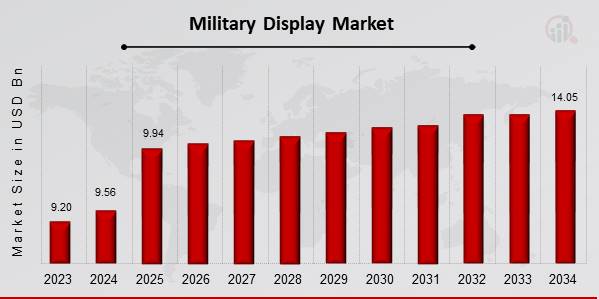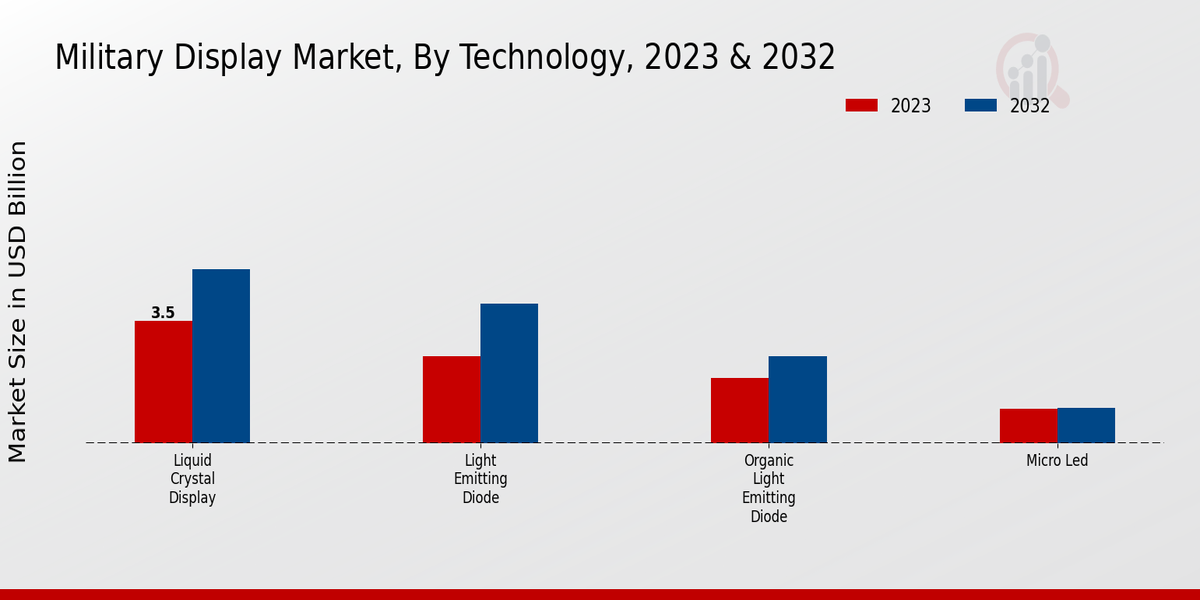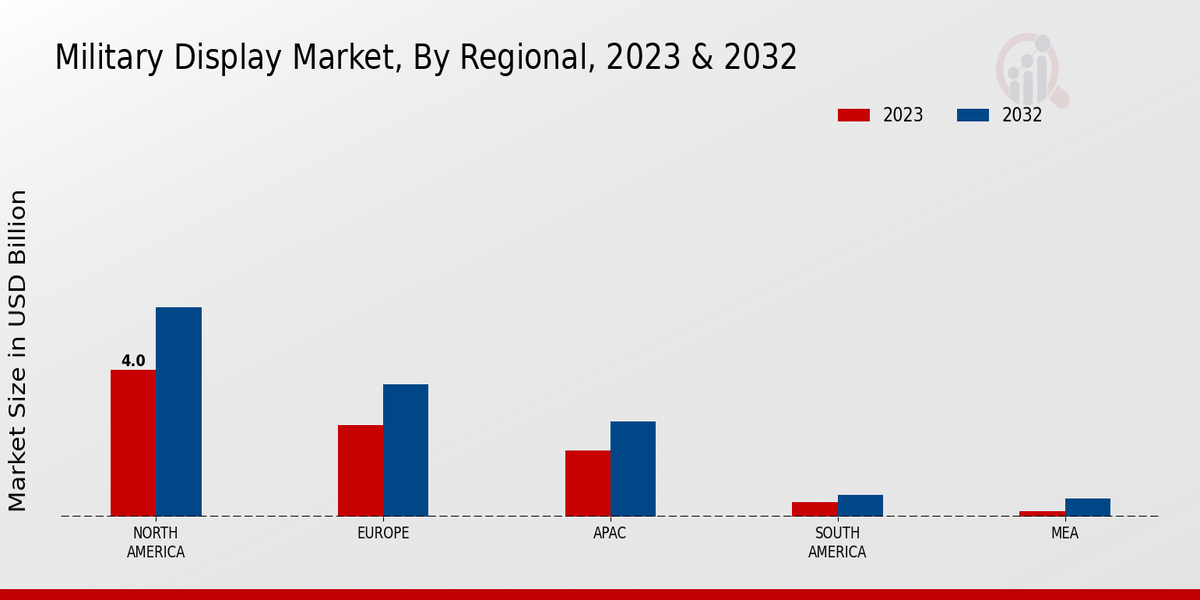Global Military Display Market Overview
The Military Display Market Size was estimated at 9.56 (USD Billion) in 2024. The Military Display Market is expected to grow from 9.94 (USD Billion) in 2025 to 14.05 (USD Billion) by 2034. The Military Display Market CAGR (growth rate) is expected to be around 3.9% during the forecast period (2025 - 2034).

Source: Primary Research, Secondary Research, MRFR Database and Analyst Review
Key Military Display Market Trends Highlighted
The Global Military Display Market is experiencing significant growth driven by the increasing demand for advanced visual technologies in defense applications. Enhanced situational awareness, the integration of high-resolution display systems, and advancements in hardware and software capabilities serve as key market drivers.
Governments around the world are focusing on modernizing their defense capabilities, increasing military budgets, and investing in research and development for next-generation display technology. This push for improved communication and efficiency within military operations is creating a robust environment for advancements in military displays.
There are ample opportunities for manufacturers and technology providers to explore this market. The rise of unmanned systems and integrated battlefield solutions offers a platform for innovative display applications.
Additionally, the growing importance of simulation and training environments emphasizes the need for advanced display solutions that can provide realistic experiences for military personnel. Collaborations between defense contractors and technology firms could yield unique products tailored to specific military requirements, thereby capturing a share of this evolving market.
Trends in recent times indicate a shift towards more ruggedized and adaptable display technologies capable of functioning in harsh military environments.
The integration of augmented reality and virtual reality in defense training and operational settings is gaining traction, offering immersive experiences that enhance training efficacy. Moreover, the emphasis on electronic warfare and cyber defense is leading to an increased focus on secure and resilient display solutions.
As technology continues to evolve, the military display market is expected to adapt, providing innovative solutions to meet the ever-changing demands of the defense sector.
Military Display Market Drivers
Increasing Defense Budgets Across Global Powers
The continuous rise in defense budgets among various nations is a significant driver for the Global Military Display Market.
Governments are increasingly allocating more funds towards the modernization of their military forces, which includes upgrading technological advancements in communication and display systems. As military organizations recognize the importance of advanced display solutions for intelligence, surveillance, reconnaissance, and situational awareness, the demand for high-quality military displays surges.
Enhanced military display technologies improve operational effectiveness, and the capability to make informed decisions in real time is critical for military missions. Additionally, the growing complexity of warfare necessitates the adoption of integrated display systems that can work seamlessly with various platforms, reinforcing the push toward investment in modern military display solutions.
Countries are also focusing on enhancing their cybersecurity measures, leading to increased demand for military displays that can provide secure, reliable, and up-to-date information.
Such advancements are essential as they contribute to increased situational awareness and strategic planning, ensuring forces are prepared to respond effectively to evolving threats.
Consequently, the augmentation of defense budgets not only supports the procurement of advanced military displays but also signifies a broader commitment to enhancing defense capabilities, creating a robust market growth scenario for the Global Military Display Market.
Technological Advancements in Display Technologies
The rapid technological advancements in display technologies serve as a powerful catalyst for the Global Military Display Market. Innovations such as LED, OLED, and MicroLED displays are transforming the landscape by offering superior image quality, reduced power consumption, and greater versatility in military applications.
The integration of augmented reality (AR) and virtual reality (VR) technologies into military displays further enhances situational awareness and training capabilities.
Enhanced graphics processing capabilities allow for better performance in demanding operational environments, making these advanced displays essential for modern warfare scenarios. As technology continues to evolve, militaries worldwide are compelled to update their display systems to maintain a competitive edge.
Growing Need for Enhanced Situational Awareness
The increasing complexity of modern warfare conditions necessitates improved situational awareness for military personnel, driving the demand for advanced display systems in the Global Military Display Market.
With the need to process vast amounts of data from various sources quickly, military displays equipped with real-time data visualization capabilities are crucial. These displays assist commanders and operators in making informed decisions rapidly and accurately, which is vital in high-stakes environments.
Enhanced situational awareness contributes to mission success and the safety of military personnel, spurring further investment in sophisticated display technologies.
Military Display Market Segment Insights:
Military Display Market Technology Insights
The Liquid Crystal Display (LCD) segment dominated this landscape, accounting for a valuation of 3.5 USD Billion in 2023 and expected to reach 5.0 USD Billion by 2032. This segment's significance lies in its widespread use in various military applications, offering advantages in terms of clarity, energy efficiency, and adaptability in diverse environments.
Following closely was the Light Emitting Diode (LED) segment, valued at 2.5 USD Billion in 2023 and anticipated to expand to 4.0 USD Billion by 2032. LEDs are noted for their durability and low power consumption, making them increasingly essential in modern military operations, including surveillance and communication systems.
The Organic Light Emitting Diode (OLED) segment captured value at 1.86 USD Billion in 2023 and is projected to grow to 2.5 USD Billion by 2032. OLED technology is recognized for its exceptional color accuracy and flexibility, providing enhanced display options that are vital for advanced military visual systems.
Lastly, the Micro LED segment held a relatively smaller market share with a valuation of 0.99 USD Billion in 2023, growing to 1.0 USD Billion by 2032; however, its significance lies in its potential for superior brightness and energy efficiency, which could drive its adoption in specialized military applications.
Overall, the Global Military Display Market segmentation reveals a harmonious integration of technology advancements catering to the multifaceted requirements of modern military operations, emphasizing the continued importance of display technologies in enhancing situational awareness and operational effectiveness.

Source: Primary Research, Secondary Research, MRFR Database and Analyst Review
Military Display Market Application Insights
The Aviation sector is crucial for providing pilots with real-time data and enhanced situational awareness, significantly contributing to the market's steady expansion. The Land application, including ground vehicles, plays a vital role in enhancing operational efficiencies and safety through advanced display technologies.
The Naval segment is important as it enhances maritime security and operations, integrating sophisticated display systems for command and control.
C4ISR stands for Command, Control, Communications, Computers, Intelligence, Surveillance, and Reconnaissance, and it dominates the market by ensuring effective decision-making through integrated systems that offer comprehensive battlefield awareness.
Collectively, these applications represent a significant portion of the Global Military Display Market revenue and are pivotal for modernizing defense capabilities, driven by technological advancements and the increasing need for efficient military operations.
The Global Military Display Market statistics reflect a trend toward innovation and integration across these applications, highlighting the importance of continuous investment in advanced display solutions to combat emerging challenges.
Military Display Market Display Type Insights
Within this market, Rugged Displays stand out due to their durability and reliability under extreme conditions, making them a prime choice for battlefield environments.
Portable Displays facilitate mobile operations and enhance situational awareness, proving critical for personnel stationed in diverse locations. Fixed Displays, on the other hand, serve as essential components in control rooms and command centers, offering stability and consistent performance.
The combination of these display types contributes significantly to the Global Military Display Market revenue, with each category playing a unique role in enhancing overall military effectiveness. The ongoing advancements in display technology and the demand for improved mission-critical applications are anticipated to drive growth in this market segment, reflecting key trends in innovation and functionality.
Factors such as increasing defense budgets and evolving threats necessitate robust display solutions across various military applications, ensuring that the Global Military Display Market segmentation continues to evolve to meet the needs of modern armed forces.
Military Display Market End Use Insights
The segment is primarily segmented into Defense, Military Operations, and Training and Simulation, each playing a pivotal role in market dynamics. Defense, as a vital component, emphasizes advanced technologies for communication and situational awareness, which are critical for tactical advantage.
Military Operations benefit from real-time displays that enhance mission effectiveness and decision-making on the field.
Training and Simulation hold a significant share, providing immersive experiences that enhance skills and preparedness among personnel. As the military increasingly adopts modern strategies and technologies, the demand for sophisticated display solutions within these segments is expected to rise.
The evolving landscape of warfare, combined with advancements in display technology, presents numerous opportunities for innovation within the Global Military Display Market.
Furthermore, the segment's growth is supported by the increasing focus on enhanced training methodologies and operational efficiency in military applications, ensuring that each segment remains crucial to overall market progress.
Military Display Market Regional Insights
Within the Regional segment, North America emerged as a dominant force, holding a significant majority with a valuation of 4.0 USD Billion and expected to grow to 5.7 USD Billion by 2032, driven by advanced defense technologies and substantial military investments.
Europe followed with a notable valuation of 2.5 USD Billion in 2023, reflecting its commitment to upgrading military capabilities and interoperability. The APAC region, while smaller at 1.8 USD Billion, was witnessing rapid growth fueled by increasing defense budgets and geopolitical tensions, expecting an increase to 2.6 USD Billion.
South America and MEA, valued at 0.4 USD Billion and 0.16 USD Billion respectively in 2023, demonstrated emerging opportunities for market growth as defense spending escalates in response to security challenges.
The overall Global Military Display Market revenue is shaped by varying factors such as regional defense policies, technological advancements, and the increasing need for secure communication systems across different military platforms.

Source: Primary Research, Secondary Research, MRFR Database and Analyst Review
Military Display Market Key Players and Competitive Insights:
The Global Military Display Market is characterized by intense competition driven by technological advancements and the increasing demand for sophisticated display solutions in military operations. As nations prioritize modernization and efficiency within their armed forces, the market has witnessed a surge in investments aimed at bolstering the capabilities of military display systems.
Numerous players are vying for market share, leading to innovative product offerings that cater to varying operational requirements. The competition is primarily shaped by factors such as product performance, durability, size, weight, and integration with existing military technologies, all of which play crucial roles in determining contract wins among defense contractors.
Hewlett Packard Enterprise has established a significant presence in the Global Military Display Market, leveraging its strengths in computing and display technology. The company is recognized for its commitment to developing high-performance display solutions that integrate seamlessly with military-grade systems.
Its ability to provide comprehensive support in the realms of cybersecurity, data management, and shared information systems bolsters its appeal to defense agencies seeking reliable and efficient display solutions.
Furthermore, Hewlett Packard Enterprise's investment in research and development ensures continuous product innovation, keeping pace with evolving military requirements. The robustness of its supply chain and established reputation for quality add to its competitive edge, making it a formidable player in this specialized market.
Rockwell Collins also plays a crucial role in the Global Military Display Market, known for its cutting-edge avionics and communication solutions tailored for military applications. The company focuses on delivering advanced display technologies that enhance situational awareness and operational effectiveness for military personnel.
With a strong emphasis on user-centric design, Rockwell Collins ensures that its display solutions cater to the specific needs of users, enhancing their usability in dynamic environments. The company’s strategic collaborations with various defense entities allow it to stay ahead in terms of technological advancements and market requirements.
Rockwell Collins' dedication to meeting stringent military specifications and delivering high-reliability products positions it as a key competitor within the military display sector, further strengthening its market presence and influence.
Key Companies in the Military Display Market Include:
Military Display Market Developments
Recent developments in the Global Military Display Market indicate a dynamic environment fueled by technological advancements and strategic partnerships among key players. Companies such as Lockheed Martin and Northrop Grumman are increasingly focused on integrating advanced display technologies into their systems, enhancing situational awareness for military personnel.
The market has witnessed notable growth in companies like L3Harris Technologies and Elbit Systems, both of which are emphasizing innovation in rugged display systems for various military applications. In terms of mergers and acquisitions, there have been significant moves; for example, Rockwell Collins underwent a strategic acquisition aimed at bolstering its display capabilities and enhancing its competitive edge.
Similar strategies have been observed with Raytheon Technologies as they continue to invest in emerging technologies to expand their display solutions portfolio. As global defense budgets rise, particularly in North America and Europe, the market valuation for military displays is set to increase, driven by the demand for improved performance and reliability in military operations.
This growth in market value is influencing R&D investments across companies such as BAE Systems and Thales Group, positioning them for future opportunities in the military display sector.
Military Display Market Segmentation Insights
| Report Attribute/Metric |
Details |
| Market Size 2024 |
9.54(USD Billion) |
| Market Size 2025 |
9.94 (USD Billion) |
| Market Size 2034 |
14.05(USD Billion) |
| Compound Annual Growth Rate (CAGR) |
3.9% (2025 - 2034) |
| Report Coverage |
Revenue Forecast, Competitive Landscape, Growth Factors, and Trends |
| Base Year |
2023 |
| Market Forecast Period |
2025 - 2034 |
| Historical Data |
2019 - 2023 |
| Market Forecast Units |
USD Billion |
| Key Companies Profiled |
Hewlett Packard Enterprise, Rockwell Collins, General Dynamics, Textron, Lockheed Martin, L3Harris Technologies, Leonardo, Honeywell, Northrop Grumman, BAE Systems, Saab, Raytheon Technologies, Elbit Systems, Thales Group, Cubic Corporation |
| Segments Covered |
Technology, Application, Display Type, End Use, Regional |
| Key Market Opportunities |
Increased defense budgets globally, Rising demand for advanced technology, Integration of AI in displays, Growth in simulation and training, and Enhanced demand for ruggedized displays |
| Key Market Dynamics |
Rising defense budgets, Technological advancements, Demand for rugged displays, Shift towards digitization, and Increasing military modernizations |
| Countries Covered |
North America, Europe, APAC, South America, MEA |
Frequently Asked Questions (FAQ) :
The Global Military Display Market is expected to be valued at 14.05 USD Billion by 2034.
The Global Military Display Market is projected to have a CAGR of 3.9% from 2025 to 2034.
North America is expected to hold the largest market share, valued at 5.7 USD Billion by 2032.
The Liquid Crystal Display segment is projected to be valued at 5.0 USD Billion by 2032.
The Light Emitting Diode segment is anticipated to be valued at 4.0 USD Billion by 2032.
Key players in the market include companies such as Hewlett Packard Enterprise, General Dynamics, and Raytheon Technologies.
South America is expected to have the smallest market size, valued at 0.6 USD Billion by 2032.
The Organic Light Emitting Diode segment is expected to be valued at 2.5 USD Billion by 2032.
The Micro LED segment is anticipated to be valued at 1.0 USD Billion by 2032.
Challenges may include evolving technology requirements and geopolitical tensions impacting defense budgets.

















